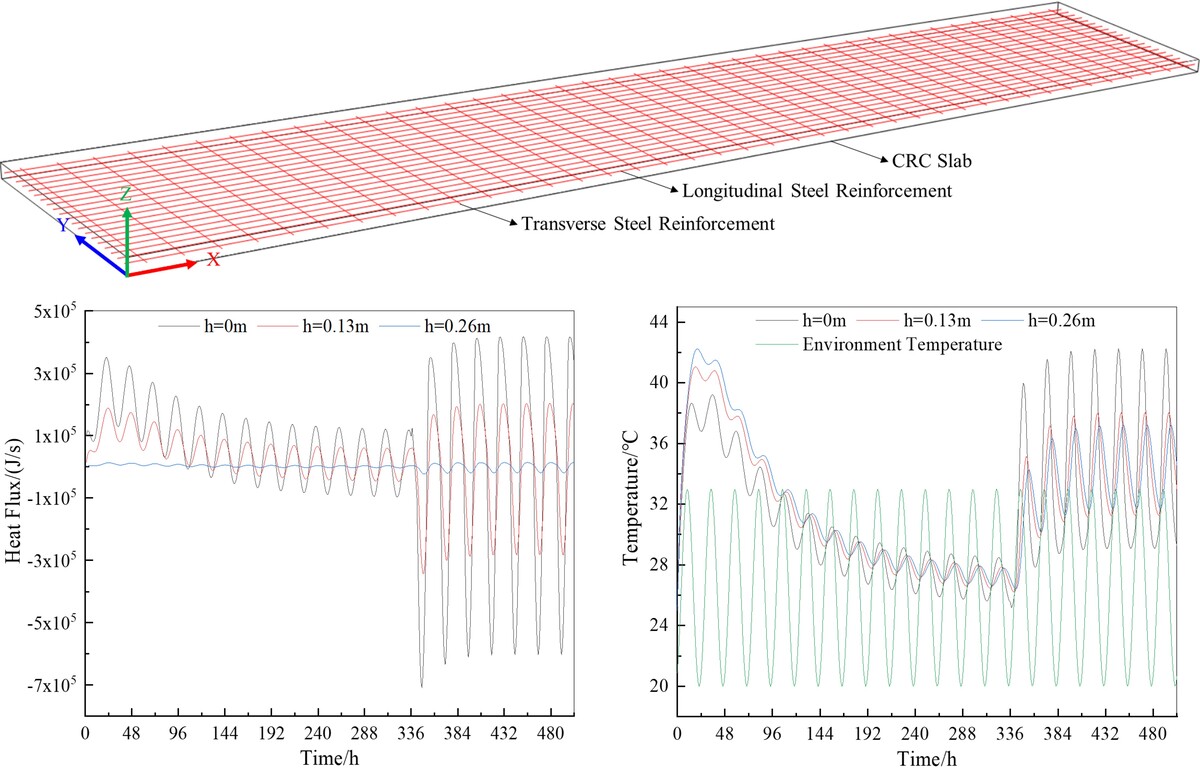Research on performance improvement of high slump concrete for continuously reinforced concrete pavement
1
Key Laboratory of Special Environment Road Engineering of Hunan Province, Changsha University of Science & Technology, Changsha, 410114, People’s Republic of China
2
School of Transportation, Changsha University of Science & Technology, Changsha, 410114, People's Republic of China
Submission date: 2023-06-30
Final revision date: 2024-05-13
Acceptance date: 2025-07-24
Publication date: 2025-08-05
Corresponding author
Miao Wang
School of Traffic and Transportation Engineering, Changsha University of Science & Technology, No. 960, Section 2, Wanjiali South Road, Tianxin D, 410114, Changsha, China
School of Traffic and Transportation Engineering, Changsha University of Science & Technology, No. 960, Section 2, Wanjiali South Road, Tianxin D, 410114, Changsha, China
Cement Wapno Beton 30(1) 14-37 (2025)
KEYWORDS
uniformitycracking resistanceperformance improvementhigh slump concretecontinuously reinforced concrete pavementmix proportion optimization
TOPICS
ABSTRACT
During the construction of Continuously Reinforced Concrete Pavement [CRCP], the lateral pouring method requires the high slump of concrete. In order to improve the performance of High Slump Concrete [HSC] for CRCP, an orthogonal experiment was designed to optimize the HSC mix proportion, and the matrix analysis method was used to determine the optimal mix proportion. Furthermore, the early age cracking risk of HSC-CRCP structure was analyzed by ABAQUS. Hydroxypropyl Methyl Cellulose [HPMC] and Basalt Fibers [BF] were used to enhance the performance of HSC, and the optimal contents of HPMC and BF were determined. The results showed that the importance ranking of various factors was: water-binder ratio [W/B] > polycarboxylate superplasticizer content [PCE/%] > sand ratio [βs/%] > slag powder content [SP/%] > fly ash content [FA/%]. The HSC-CRCP structure still had cracking risk during the early age of 15~21 days. The optimal content of HPMC and BF was 0.025 % and 0.15 %, respectively. The segregation rate [SR], shrinkage rate of 28 day early age [ε], and total cracking area per unit area [c] of HSC were reduced by 87.4 %, 37.0 %, and 38.9 %, respectively, while the compressive strength [fcu], splitting tensile strength [fts], and flexural strength [ff] were increased by 9.8 %, 11.0 %, and 7.1 %, respectively. The findings have significant value for improving the durability of CRCP.
REFERENCES (52)
1.
M.G. Chorzepa, C. Johnson, S. Durham, S.S. Kim, Forensic Investigation of Continuously Reinforced Concrete Pavements in Fair and Poor Condition. J. Perform. Constr. Facil. 32, 04018031 (2018). https://doi.org/10.1061/(ASCE)....
2.
S. Li, F. Yang, Z. Liu, A new structure for continuously reinforced concrete pavement with road performance evaluation. Constr Build Mater 157, 1047–1052 (2017). https://doi.org/10.1016/j.conb....
3.
Y. Zhang, Z. Huang, Transverse Crack Behavior in Continuously Reinforced Concrete Pavement with Basalt Fiber Reinforcement. Appl. Sci.-Basel 10, 7458 (2020). https://doi.org/10.3390/app102....
4.
M. Liu, X. Huang, X. Chen, Occurrence and impacts of hollow space under a continuously reinforced concrete pavement. Road Mater. Pavement Des. 17, 203–222 (2016). https://doi.org/10.1080/146806....
5.
S.-M. Kim, Y.K. Cho, J.H. Lee, Advanced reinforced concrete pavement: Concept and design. Constr. Build. Mater. 231, 117130 (2020). https://doi.org/10.1016/j.conb....
6.
J.R. Roesler, J.E. Hiller, A.S. Brand, Continuously reinforced concrete pavement manual, guidelines for design, construction, maintenance, and rehabilitation, United States. Federal Highway Administration, 2016.
7.
I. Navarrete, M. Lopez, Understanding the relationship between the segregation of concrete and coarse aggregate density and size. Constr. Build. Mater. 149, 741–748 (2017). https://doi.org/10.1016/j.conb....
8.
M.M.A. Pratama, N. Nindyawati, P. Puspitasari, A.A. Permanasari, H. Prayuda, U.C. Sari, Experimental modelling of segregation on reinforced concrete beam using a graded concrete approach. J. Phys.: Conf. Ser. 1833, 012023 (2021). https://doi.org/10.1088/1742-6....
9.
Z. Xu, Calculation of visible crack width of concrete surface under temperature and shrinkage gradient deformations. Struct. Concr. 20, 2109–2121 (2019). https://doi.org/10.1002/suco.2....
10.
S.S. Mousavi, L. Guizani, C. Bhojaraju, C.M. Ouellet-Plamondon, Effect of concrete workability on bond properties of steel rebar in pre-cracked concrete. Procc. Inst. Civil Eng. Struct. Build. 1–14 (2022). https://doi.org/10.1680/jstbu.....
11.
H.S. Gökçe, Ö. Andiç-Çakır, Bleeding characteristics of high consistency heavyweight concrete mixtures. Constr. Build. Mater. 194, 153–160 (2019). https://doi.org/10.1016/j.conb....
12.
K. Ouzaa, M.B. Benmansour, Cracks in Continuously Reinforced Concrete Pavement. Arab. J. Sci. Eng. 39, 8593–8608 (2014). https://doi.org/10.1007/s13369....
13.
D.-Y. Yoo, J.-J. Park, S.-W. Kim, Y.-S. Yoon, Influence of reinforcing bar type on autogenous shrinkage stress and bond behavior of ultra high performance fiber reinforced concrete. Cem. Concr. Comp. 48, 150–161 (2014). https://doi.org/10.1016/j.cemc....
14.
X. Liu, Y. Yuan, Q. Su, Sensitivity analysis of the early‐age cracking risk in an immersed tunnel. Struct. Concr. 15, 179–190 (2014). https://doi.org/10.1002/suco.2....
15.
Y. Liu, A.K. Schindler, J.S. Davidson, Finite-Element Modeling and Analysis of Early-Age Cracking Risk of Cast-In-Place Concrete Culverts. Transp. Res. Rec. 2672, 24–36 (2018). https://doi.org/10.1177/036119....
16.
A.M. Solak, A.J. Tenza-Abril, V.E. García-Vera, Influence of The Segregation Phenomenon on Structural Efficiency of Lightweight Aggregate Concretes. Materials 13, 5754 (2020). https://doi.org/10.3390/ma1324....
17.
K. Amini, I. Mehdipour, S.D. Hwang, M. Shekarchi, Effect of binder composition on time-dependent stability and robustness characteristics of self-consolidating mortar subjected to prolonged agitation. Constr. Build. Mater. 112, 654–665 (2016). https://doi.org/10.1016/j.conb....
18.
J. Han, P. Yan, Influence of segregation on the permeability of self-consolidating concrete. Constr. Build. Mater. 269, 121277 (2021). https://doi.org/10.1016/j.conb....
19.
W. Cui, R.-C. Miao, W.-S. Yan, H. Song, Z. Jiang, Static segregation of fresh high workable concrete based on an image processing method. Constr. Build. Mater. 361, 129708 (2022). https://doi.org/10.1016/j.conb....
20.
A. Solak, A. Tenza-Abril, J. Saval, V. García-Vera, Effects of Multiple Supplementary Cementitious Materials on Workability and Segregation Resistance of Lightweight Aggregate Concrete. Sustainability 10, 4304 (2018). https://doi.org/10.3390/su1011....
21.
P. Dybeł, Effect of self-compacting concrete placement technology on the load-bearing capacity of the concrete-concrete and steel-concrete bond in layered elements. Cem. Wapno Beton 28, 210–224 (2023). https://doi.org/10.32047/CWB.2....
22.
T. Stepinski, A. Dmowska, Communicating racial segregation: Abstract versus concrete. Proc. Natl. Acad. Sci. U.S.A. 116, 22435–22436 (2019). https://doi.org/10.1073/pnas.1....
23.
Y. Gao, C. Zou, Experimental study on segregation resistance of nanoSiO2 fly ash lightweight aggregate concrete. Constr. Build. Mater. 93, 64–69 (2015). https://doi.org/10.1016/j.conb....
24.
X. Gu, X. Li, W. Zhang, Y. Gao, Y. Kong, J. Liu, X. Zhang, Effects of HPMC on Workability and Mechanical Properties of Concrete Using Iron Tailings as Aggregates. Materials 14, 6451 (2021). https://doi.org/10.3390/ma1421....
25.
M. Sirajuddin, R. Gettu, Plastic shrinkage cracking of concrete incorporating mineral admixtures and its mitigation. Mater. Struct. 51, 48 (2018). https://doi.org/10.1617/s11527....
26.
B. Persson, Eight-year exploration of shrinkage in high-performance concrete. Cem. Concr. Res. 32, 1229–1237 (2002). https://doi.org/10.1016/S0008-....
27.
B. Bissonnette, P. Pierre, M. Pigeon, Influence of key parameters on drying shrinkage of cementitious materials. Cem. Concr. Res. 29, 1655–1662 (1999). https://doi.org/10.1016/S0008-....
28.
J. Stark, Recent advances in the field of cement hydration and microstructure analysis. Cem. Concr. Res. 41, 666–678 (2011). https://doi.org/10.1016/j.cemc....
29.
F. Ullah, F. Al-Neshawy, J. Punkki, Early Age Autogenous Shrinkage of Fibre Reinforced Concrete. Nordic Concr. Res. 59, 59–72 (2018). https://doi.org/10.2478/ncr-20....
30.
M. Gupta, R. Raj, A.K. Sahu, Mechanical properties of high strength concrete incorporating chopped basalt fibers: experimental and analytical study. Mater. Res. Exp. 9, 125305 (2022). https://doi.org/10.1088/2053-1....
31.
R. Henkensiefken, D. Bentz, T. Nantung, J. Weiss, Volume change and cracking in internally cured mixtures made with saturated lightweight aggregate under sealed and unsealed conditions. Cem. Concr. Comp. 31, 427–437 (2009). https://doi.org/10.1016/j.cemc....
32.
C. Song, Y.C. Choi, S. Choi, Effect of internal curing by superabsorbent polymers – Internal relative humidity and autogenous shrinkage of alkali-activated slag mortars. Constr. Build. Mater. 123, 198–206 (2016). https://doi.org/10.1016/j.conb....
33.
G. Knor, R. Jaskulski, M.A. Glinicki, J. Holnicki-Szulc, Numerical identification of the thermal properties of early age concrete using inverse heat transfer problem. Heat Mass Trans. 55, 1215–1227 (2019). https://doi.org/10.1007/s00231....
34.
C. Parra, M. Valcuende, F. Gómez, Splitting tensile strength and modulus of elasticity of self-compacting concrete. Constr. Build. Mater. 25, 201–207 (2011). https://doi.org/10.1016/j.conb....
35.
B.P. Singh, N. Yazdani, G. Ramirez, Effect of a Time Dependent Concrete Modulus of Elasticity on Prestress Losses in Bridge Girders. Int. J. Concr. Struct. Mater. 7, 183–191 (2013). https://doi.org/10.1007/s40069....
36.
W. Gu, Experimental study on Mechanical properties of C40 commercial concrete at early age, Master, Beijing Jiaotong University, 2012. https://kns.cnki.net/kcms2/art... (accessed May 10, 2023).
37.
C.-F.M. Code, CEB-FIP model code for concrete structures, euro-international committe for concrete, Bulletin (1990).
38.
M. Chai, C. Hu, L. Wang, T. Chen, Study on the Evolution Behavior of Humidity Fields in Cement Concrete Pavements of a Coastal Airport During Early Stages in Humid and Hot Areas. Materials 16, 5643 (2023). https://doi.org/10.3390/ma1616....
39.
B. Cao, W. Li, Z. Li, Simplification and experimental verification for temperature and humidity field coupling model of conservatory soil. Trans. Tianjin Univ. 17, 33–38 (2011). https://doi.org/10.1007/s12209....
40.
H. Li, J. Liu, Y. Wang, T. Yao, Q. Tian, S. Li, Deformation and cracking modeling for early-age sidewall concrete based on the multi-field coupling mechanism. Constr. Build. Mater. 88, 84–93 (2015). https://doi.org/10.1016/j.conb....
41.
D.F.T. Razakamandimby R., H.-T. Kim, T.-S. Han, Y.H. Lee, K. Park, Recursive aggregate segmentation by erosion and reconstitution (RASER) to characterize concrete microstructure using complementarity of X-ray and neutron computed tomography. Cem. Concr. Comp. 148, 105437 (2024). https://doi.org/10.1016/j.cemc....
42.
J. Szydłowski, Application of digital image analysis as a method of assessing the of carbonation process of cement binders – impact of distortion on the results of real and model samples. Cem. Wapno Beton 28, 92–104 (2023). https://doi.org/10.32047/CWB.2....
43.
O. Xu, S. Han, Y. Liu, C. Li, Experimental investigation surface abrasion resistance and surface frost resistance of concrete pavement incorporating fly ash and slag. Int. J. Pavem. Eng. 22, 1858–1866 (2021). https://doi.org/10.1080/102984....
44.
Q. Li, Q. Zhang, Experimental study on the compressive strength and shrinkage of concrete containing fly ash and ground granulated blast‐furnace slag. Struct. Concr. 20, 1551–1560 (2019). https://doi.org/10.1002/suco.2....
45.
B. Klemczak, J. Gołaszewski, A. Smolana, M. Gołaszewska, G. Cygan, Shrinkage behaviour of self-compacting concrete with a high volume of fly ash and slag experimental tests and analytical assessment. Constr. Build. Mater. 400, 132608 (2023). https://doi.org/10.1016/j.conb....
46.
S. Afroz, Y. Zhang, Q.D. Nguyen, T. Kim, A. Castel, Shrinkage of blended cement concrete with fly ash or limestone calcined clay. Mater. Struct. 56, 15 (2023). https://doi.org/10.1617/s11527....
47.
J. Chakraborty, S. Banerjee, Replacement of Cement by Fly Ash in Concrete. IJCE 3, 58–60 (2016). https://doi.org/10.14445/23488....
48.
A. Yadav, N.K. Yadav, Study of Fly Ash Cement Concrete Pavement. IJCE 4, 1–6 (2017). https://doi.org/10.14445/23488....
49.
C. Gu, J. Yao, S. Huang, Y. Yang, J. Liu, T. Ni, Z. Yang, Study on early-age tensile properties of high volume fly ash concrete. Mater. Struct. 55, 135 (2022). https://doi.org/10.1617/s11527....
50.
Y. Li, A. Shen, H. Wu, Fractal Dimension of Basalt Fiber Reinforced Concrete (BFRC) and Its Correlations to Pore Structure, Strength and Shrinkage. Materials 13, 3238 (2020). https://doi.org/10.3390/ma1314....
51.
X. Wang, J. He, A.S. Mosallam, C. Li, H. Xin, The Effects of Fiber Length and Volume on Material Properties and Crack Resistance of Basalt Fiber Reinforced Concrete (BFRC). Adv. Mater. Sci. Eng. 2019, e7520549 (2019). https://doi.org/10.1155/2019/7....
52.
A.B. Kizilkanat, N. Kabay, V. Akyüncü, S. Chowdhury, A.H. Akça, Mechanical properties and fracture behavior of basalt and glass fiber reinforced concrete: An experimental study. Constr. Build. Mater. 100, 218–224 (2015). https://doi.org/10.1016/j.conb....
We process personal data collected when visiting the website. The function of obtaining information about users and their behavior is carried out by voluntarily entered information in forms and saving cookies in end devices. Data, including cookies, are used to provide services, improve the user experience and to analyze the traffic in accordance with the Privacy policy. Data are also collected and processed by Google Analytics tool (more).
You can change cookies settings in your browser. Restricted use of cookies in the browser configuration may affect some functionalities of the website.
You can change cookies settings in your browser. Restricted use of cookies in the browser configuration may affect some functionalities of the website.




